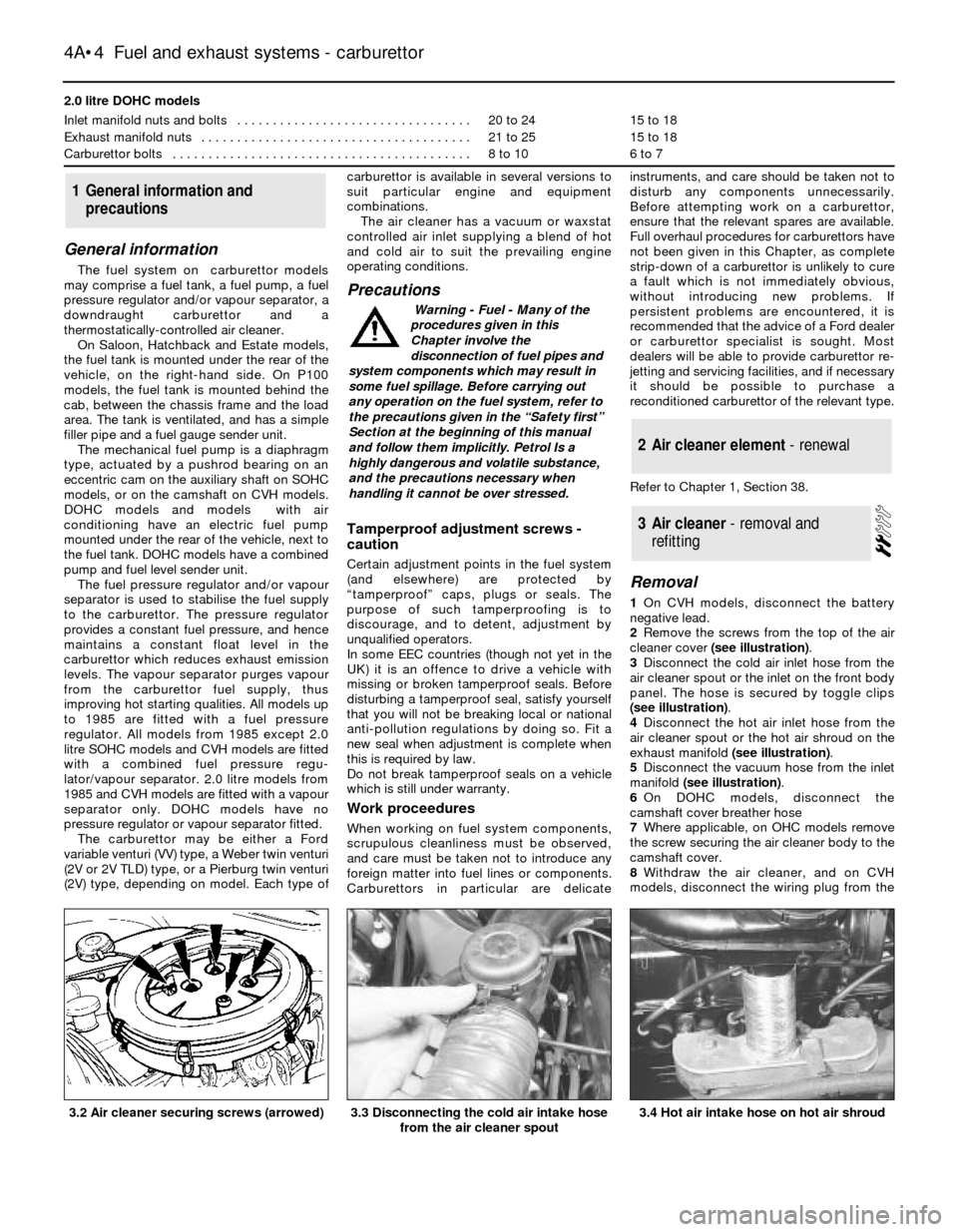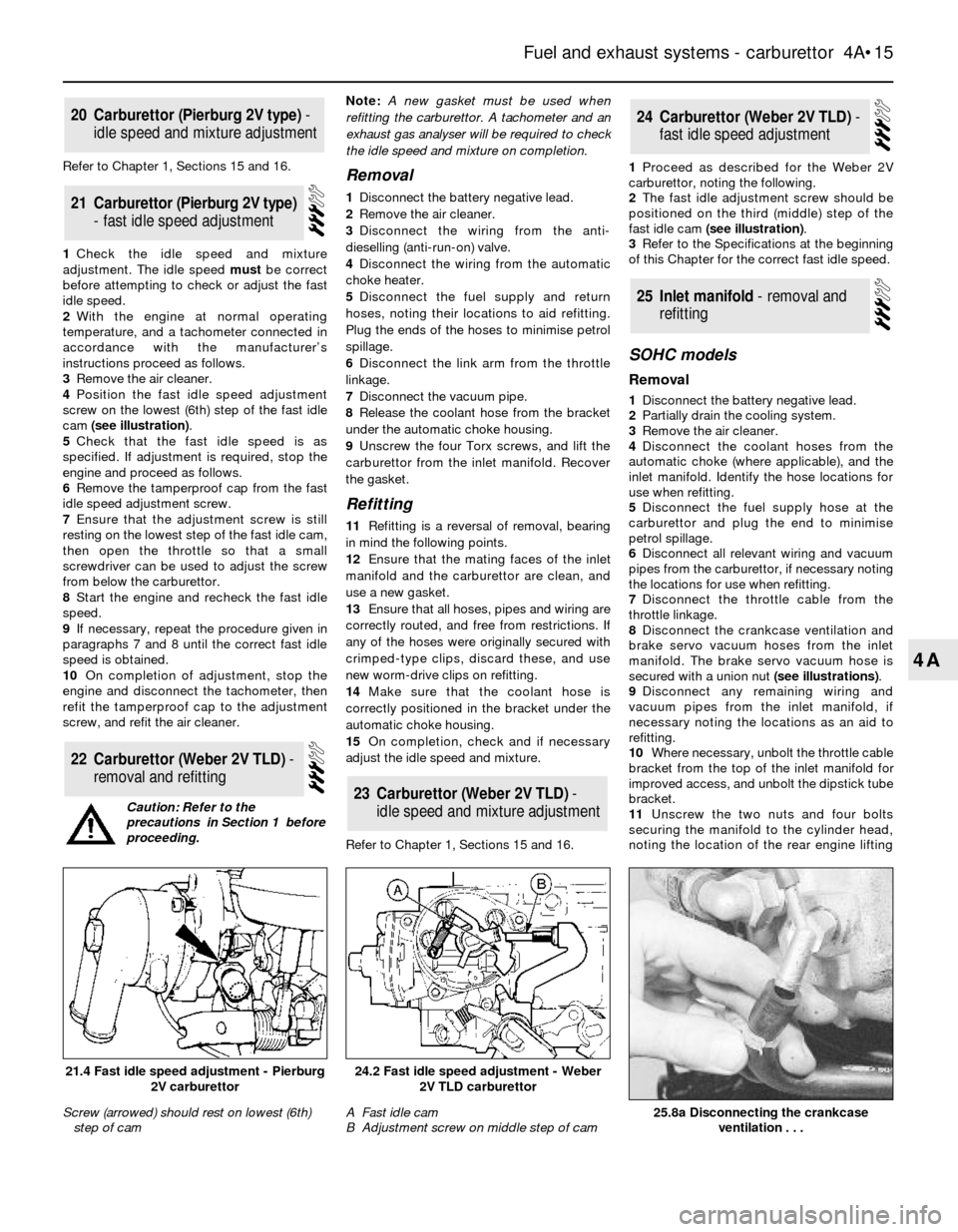roof FORD SIERRA 1983 1.G Fuel And Exhaust Systems Carburettor Workshop Manual
[x] Cancel search | Manufacturer: FORD, Model Year: 1983, Model line: SIERRA, Model: FORD SIERRA 1983 1.GPages: 20, PDF Size: 0.83 MB
Page 4 of 20

2.0 litre DOHC models
Inlet manifold nuts and bolts . . . . . . . . . . . . . . . . . . . . . . . . . . . . . . . . .20 to 2415 to 18
Exhaust manifold nuts . . . . . . . . . . . . . . . . . . . . . . . . . . . . . . . . . . . . . .21 to 2515 to 18
Carburettor bolts . . . . . . . . . . . . . . . . . . . . . . . . . . . . . . . . . . . . . . . . . .8 to 106 to 7
General information
The fuel system on carburettor models
may comprise a fuel tank, a fuel pump, a fuel
pressure regulator and/or vapour separator, a
downdraught carburettor and a
thermostatically-controlled air cleaner.
On Saloon, Hatchback and Estate models,
the fuel tank is mounted under the rear of the
vehicle, on the right-hand side. On P100
models, the fuel tank is mounted behind the
cab, between the chassis frame and the load
area. The tank is ventilated, and has a simple
filler pipe and a fuel gauge sender unit.
The mechanical fuel pump is a diaphragm
type, actuated by a pushrod bearing on an
eccentric cam on the auxiliary shaft on SOHC
models, or on the camshaft on CVH models.
DOHC models and models with air
conditioning have an electric fuel pump
mounted under the rear of the vehicle, next to
the fuel tank. DOHC models have a combined
pump and fuel level sender unit.
The fuel pressure regulator and/or vapour
separator is used to stabilise the fuel supply
to the carburettor. The pressure regulator
provides a constant fuel pressure, and hence
maintains a constant float level in the
carburettor which reduces exhaust emission
levels. The vapour separator purges vapour
from the carburettor fuel supply, thus
improving hot starting qualities. All models up
to 1985 are fitted with a fuel pressure
regulator. All models from 1985 except 2.0
litre SOHC models and CVH models are fitted
with a combined fuel pressure regu-
lator/vapour separator. 2.0 litre models from
1985 and CVH models are fitted with a vapour
separator only. DOHC models have no
pressure regulator or vapour separator fitted.
The carburettor may be either a Ford
variable venturi (VV) type, a Weber twin venturi
(2V or 2V TLD) type, or a Pierburg twin venturi
(2V) type, depending on model. Each type ofcarburettor is available in several versions to
suit particular engine and equipment
combinations.
The air cleaner has a vacuum or waxstat
controlled air inlet supplying a blend of hot
and cold air to suit the prevailing engine
operating conditions.
Precautions
Tamperproof adjustment screws -
caution
Certain adjustment points in the fuel system
(and elsewhere) are protected by
“tamperproof” caps, plugs or seals. The
purpose of such tamperproofing is to
discourage, and to detent, adjustment by
unqualified operators.
In some EEC countries (though not yet in the
UK) it is an offence to drive a vehicle with
missing or broken tamperproof seals. Before
disturbing a tamperproof seal, satisfy yourself
that you will not be breaking local or national
anti-pollution regulations by doing so. Fit a
new seal when adjustment is complete when
this is required by law.
Do not break tamperproof seals on a vehicle
which is still under warranty.
Work proceedures
When working on fuel system components,
scrupulous cleanliness must be observed,
and care must be taken not to introduce any
foreign matter into fuel lines or components.
Carburettors in particular are delicateinstruments, and care should be taken not to
disturb any components unnecessarily.
Before attempting work on a carburettor,
ensure that the relevant spares are available.
Full overhaul procedures for carburettors have
not been given in this Chapter, as complete
strip-down of a carburettor is unlikely to cure
a fault which is not immediately obvious,
without introducing new problems. If
persistent problems are encountered, it is
recommended that the advice of a Ford dealer
or carburettor specialist is sought. Most
dealers will be able to provide carburettor re-
jetting and servicing facilities, and if necessary
it should be possible to purchase a
reconditioned carburettor of the relevant type.
Refer to Chapter 1, Section 38.
Removal
1On CVH models, disconnect the battery
negative lead.
2Remove the screws from the top of the air
cleaner cover (see illustration).
3Disconnect the cold air inlet hose from the
air cleaner spout or the inlet on the front body
panel. The hose is secured by toggle clips
(see illustration).
4Disconnect the hot air inlet hose from the
air cleaner spout or the hot air shroud on the
exhaust manifold (see illustration).
5Disconnect the vacuum hose from the inlet
manifold (see illustration).
6On DOHC models, disconnect the
camshaft cover breather hose
7Where applicable, on OHC models remove
the screw securing the air cleaner body to the
camshaft cover.
8Withdraw the air cleaner, and on CVH
models, disconnect the wiring plug from the
3Air cleaner - removal and
refitting
2Air cleaner element - renewal
1General information and
precautions
4A•4Fuel and exhaust systems - carburettor
3.4 Hot air intake hose on hot air shroud3.3 Disconnecting the cold air intake hose
from the air cleaner spout3.2 Air cleaner securing screws (arrowed)
Warning - Fuel - Many of the
procedures given in this
Chapter involve the
disconnection of fuel pipes and
system components which may result in
some fuel spillage. Before carrying out
any operation on the fuel system, refer to
the precautions given in the “Safety first”
Section at the beginning of this manual
and follow them implicitly. Petrol Is a
highly dangerous and volatile substance,
and the precautions necessary when
handling it cannot be over stressed.
Page 15 of 20

Refer to Chapter 1, Sections 15 and 16.
1Check the idle speed and mixture
adjustment. The idle speed must be correct
before attempting to check or adjust the fast
idle speed.
2With the engine at normal operating
temperature, and a tachometer connected in
accordance with the manufacturer’s
instructions proceed as follows.
3Remove the air cleaner.
4Position the fast idle speed adjustment
screw on the lowest (6th) step of the fast idle
cam (see illustration).
5Check that the fast idle speed is as
specified. If adjustment is required, stop the
engine and proceed as follows.
6Remove the tamperproof cap from the fast
idle speed adjustment screw.
7Ensure that the adjustment screw is still
resting on the lowest step of the fast idle cam,
then open the throttle so that a small
screwdriver can be used to adjust the screw
from below the carburettor.
8Start the engine and recheck the fast idle
speed.
9If necessary, repeat the procedure given in
paragraphs 7 and 8 until the correct fast idle
speed is obtained.
10On completion of adjustment, stop the
engine and disconnect the tachometer, then
refit the tamperproof cap to the adjustment
screw, and refit the air cleaner.Note: A new gasket must be used when
refitting the carburettor. A tachometer and an
exhaust gas analyser will be required to check
the idle speed and mixture on completion.Removal
1Disconnect the battery negative lead.
2Remove the air cleaner.
3Disconnect the wiring from the anti-
dieselling (anti-run-on) valve.
4Disconnect the wiring from the automatic
choke heater.
5Disconnect the fuel supply and return
hoses, noting their locations to aid refitting.
Plug the ends of the hoses to minimise petrol
spillage.
6Disconnect the link arm from the throttle
linkage.
7Disconnect the vacuum pipe.
8Release the coolant hose from the bracket
under the automatic choke housing.
9Unscrew the four Torx screws, and lift the
carburettor from the inlet manifold. Recover
the gasket.
Refitting
11Refitting is a reversal of removal, bearing
in mind the following points.
12Ensure that the mating faces of the inlet
manifold and the carburettor are clean, and
use a new gasket.
13Ensure that all hoses, pipes and wiring are
correctly routed, and free from restrictions. If
any of the hoses were originally secured with
crimped-type clips, discard these, and use
new worm-drive clips on refitting.
14Make sure that the coolant hose is
correctly positioned in the bracket under the
automatic choke housing.
15On completion, check and if necessary
adjust the idle speed and mixture.
Refer to Chapter 1, Sections 15 and 16.1Proceed as described for the Weber 2V
carburettor, noting the following.
2The fast idle adjustment screw should be
positioned on the third (middle) step of the
fast idle cam (see illustration).
3Refer to the Specifications at the beginning
of this Chapter for the correct fast idle speed.
SOHC models
Removal
1Disconnect the battery negative lead.
2Partially drain the cooling system.
3Remove the air cleaner.
4Disconnect the coolant hoses from the
automatic choke (where applicable), and the
inlet manifold. Identify the hose locations for
use when refitting.
5Disconnect the fuel supply hose at the
carburettor and plug the end to minimise
petrol spillage.
6Disconnect all relevant wiring and vacuum
pipes from the carburettor, if necessary noting
the locations for use when refitting.
7Disconnect the throttle cable from the
throttle linkage.
8Disconnect the crankcase ventilation and
brake servo vacuum hoses from the inlet
manifold. The brake servo vacuum hose is
secured with a union nut (see illustrations).
9Disconnect any remaining wiring and
vacuum pipes from the inlet manifold, if
necessary noting the locations as an aid to
refitting.
10Where necessary, unbolt the throttle cable
bracket from the top of the inlet manifold for
improved access, and unbolt the dipstick tube
bracket.
11Unscrew the two nuts and four bolts
securing the manifold to the cylinder head,
noting the location of the rear engine lifting
25Inlet manifold - removal and
refitting
24Carburettor (Weber 2V TLD) -
fast idle speed adjustment
23Carburettor (Weber 2V TLD) -
idle speed and mixture adjustment
22Carburettor (Weber 2V TLD) -
removal and refitting
21Carburettor (Pierburg 2V type)
- fast idle speed adjustment
20Carburettor (Pierburg 2V type) -
idle speed and mixture adjustment
Fuel and exhaust systems - carburettor 4A•15
4A
25.8a Disconnecting the crankcase
ventilation . . .
24.2 Fast idle speed adjustment - Weber
2V TLD carburettor
A Fast idle cam
B Adjustment screw on middle step of cam21.4 Fast idle speed adjustment - Pierburg
2V carburettor
Screw (arrowed) should rest on lowest (6th)
step of cam
Caution: Refer to the
precautions in Section 1 before
proceeding.